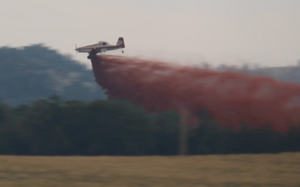![]()

A federal judge says the U-S government can keep using chemical retardant dropped from aircraft to fight wildfires, despite finding that the practice pollutes streams in western states in violation of federal law.
That’s because District Judge Dana Christensen in Missoula concluded halting the use of the red slurry material would result in greater damage, environmental damage, and loss of life from wildfires.
Environmentalists had sued the U-S Forest Service following revelations the agency dropped 213 loads of retardant into waterways over the past decade, usually by mistake. That’s less than 1% of the total number loads dropped on fires during that time.
A 2021 risk assessment showed low health risks to firefighters or other people who come into contact with fire, but the chemicals can be harmful to some fish, frogs, crustaceans and other aquatic species.
The government study found misapplied retardant could adversely affect dozens of imperiled species, including crawfish, spotted owls and fish such as shiners and suckers.
Wildfires across North America have grown bigger and more destructive over the past two decades as climate change has warmed the planet, making chemical fire retardant crucial in slowing the advance of dangerous blazes.
A coalition that includes Paradise, California – where a 2018 blaze killed 85 people and destroyed the town – praised the judge’s ruling, saying a ruling stopping the use of retardant would have put lives, homes and forests at risk.
Paradise Mayor Greg Bolin says “This case was very personal for us. Our brave firefighters need every tool in the toolbox to protect human lives and property against wildfires, and this ruling ensures we have a fighting chance this fire season.”
Fire retardant is a specialized mixture of water and chemicals that include inorganic fertilizers or salts.
It’s designed to alter the way fire burns, making blazes less intense and slowing their advance – giving firefighters time to steer flames away from inhabited areas and, in extreme situations, to evacuate people from danger.
